| Aba | |
|---|---|
| Tyrant ruler of Olba | |
 | |
| Reign | 1st century BC |
| Predecessor | Zenophanes |
Aba (flourished 1st century BC) was a female Tyrant ruler of the state of Olba in Ancient Anatolia. [1]
| Aba | |
|---|---|
| Tyrant ruler of Olba | |
 | |
| Reign | 1st century BC |
| Predecessor | Zenophanes |
Aba (flourished 1st century BC) was a female Tyrant ruler of the state of Olba in Ancient Anatolia. [1]
She was the daughter of the tyrant (absolute ruler) Zenophanes (or Xenophanes) of the Olba kingdom in Cilicia (present-day Turkey). Her father trained her in politics and she was appointed to the post of priestess prior to her rule. [2]
She succeeded her father as tyrant-ruler of Olba where a temple was located of Jupiter, founded by Ajax, son of Teucer. At the time when she ascended to the throne, it was uncommon for a woman to rule as tyrant. The exact years of her reign is not known. She reportedly succeeded her father sometime during the years between 43 BC to 39 BC, but it is not known how long she ruled. It is known that she ruled during the Final War of the Roman Republic (32–30 BC), since she is known for her policy during that war. [2]
Aba was known for her diplomatic contacts, such that Egyptian ruler Cleopatra VII of Egypt and Roman Mark Antony conferred Olba upon Aba as a favor. She was their ally during the Final War of the Roman Republic (32–30 BC). [2]
She was ultimately deposed, but her descendants ruled over Olba until its definitive incorporation into the Roman Empire. [2] [3]
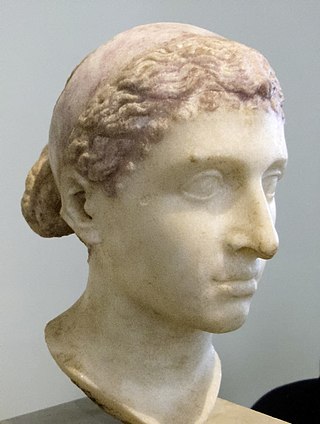
Cleopatra VII Thea Philopator was Queen of the Ptolemaic Kingdom of Egypt from 51 to 30 BC, and its last active ruler. A member of the Ptolemaic dynasty, she was a descendant of its founder Ptolemy I Soter, a Macedonian Greek general and companion of Alexander the Great. After the death of Cleopatra, Egypt became a province of the Roman Empire, marking the end of the last Hellenistic-period state in the Mediterranean and of the age that had lasted since the reign of Alexander. Her first language was Koine Greek, and she was the only known Ptolemaic ruler to learn the Egyptian language.
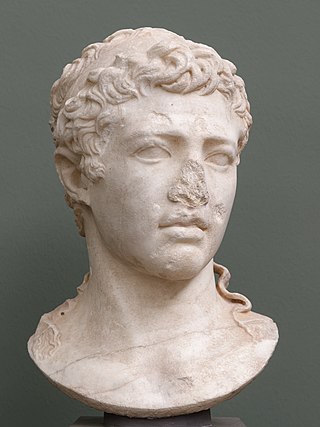
Juba II or Juba of Mauretania was the son of Juba I and client king of Numidia and Mauretania. Aside from his very successful reign, he was a highly respected scholar and author. His first wife was Cleopatra Selene II, daughter of Queen Cleopatra VII of Ptolemaic Egypt and Roman Triumvir Mark Antony.

Ptolemy of Mauretania was the last Roman client king and ruler of Mauretania for Rome. He was the son of Juba II, the king of Numidia and a member of the Berber Massyles tribe, as well as a descendant of the Ptolemaic dynasty via his mother Cleopatra Selene II.
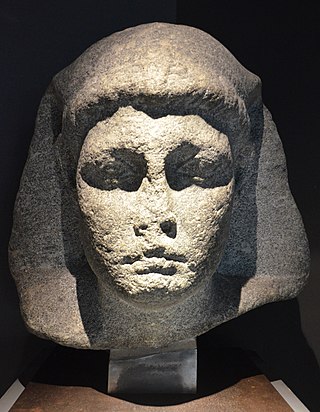
Ptolemy XV Caesar, nicknamed Caesarion, was the last pharaoh of Ptolemaic Egypt, reigning with his mother Cleopatra VII from 2 September 44 BC until her death by 12 August 30 BC, then as sole ruler until his death was ordered by Octavian.

Ptolemy XII Neos Dionysus was a king of the Ptolemaic Kingdom of Egypt who ruled from 80 to 58 BC and then again from 55 BC until his death in 51 BC. He was commonly known as Auletes, referring to his love of playing the flute in Dionysian festivals. A member of the Ptolemaic dynasty, he was a descendant of its founder Ptolemy I, a Macedonian Greek general and companion of Alexander the Great.
Berenice IV Epiphaneia was a Greek princess and Queen of the Ptolemaic dynasty. From 58 to 55 BC, Berenice IV ruled Egypt during the political exile of her father Ptolemy XII Auletes to Rome. It is unclear if she was co-ruler of Egypt with her mother Cleopatra V or a possible sibling Cleopatra VI from 58 to 57 BC, but became sole ruler in 57 BC. On the return of Ptolemy XII to Egypt with Roman military aid and an army led by Aulus Gabinius, Berenice IV was overthrown and executed by her rival father, who later bequeathed his throne to his daughter Cleopatra VII and son Ptolemy XIII as co-rulers.

Cleopatra V was a Ptolemaic Queen of Egypt. She is the only surely attested wife of Ptolemy XII. Her only known child is Berenice IV, but she was also probably the mother of Cleopatra VII. It is unclear if she died around the time of Cleopatra VII's birth in 69 BC, or if it was her or a daughter named Cleopatra VI who co-ruled Ptolemaic Egypt with Berenice IV in 58–57 BC during the political exile of Ptolemy XII to Rome. No written records about Cleopatra V exist after 57 BC and two years later Berenice IV was overthrown by Ptolemy XII, his throne restored with Roman military aid.

Ptolemy X Alexander I was the Ptolemaic king of Cyprus from 114 BC until 107 BC and of Egypt from 107 BC until his death in 88 BC. He ruled in co-regency with his mother Cleopatra III as Ptolemy Philometor Soter until 101 BC, and then with his niece and wife Berenice III as Ptolemy Philadelphus. He was a son of Ptolemy VIII and Cleopatra III, and younger brother of Ptolemy IX. His birth name was probably Alexander.

Cleopatra Selene II was a Ptolemaic princess, Queen of Numidia and Mauretania and Queen of Cyrenaica. She was an important royal woman in the early Augustan age.

Cleopatra Selene was the Queen consort of Egypt from 115 to 102 BC, the Queen consort of Syria from 102 to 92 BC, and the monarch of Syria from 82 to 69 BC. The daughter of Ptolemy VIII Physcon and Cleopatra III of Egypt, Cleopatra Selene was favoured by her mother and became a pawn in Cleopatra III's political manoeuvres. In 115 BC, Cleopatra III forced her son Ptolemy IX to divorce his sister-wife Cleopatra IV, and chose Cleopatra Selene as the new queen consort of Egypt. Tension between the king and his mother grew and ended with his expulsion from Egypt, leaving Cleopatra Selene behind; she probably then married the new king, her other brother Ptolemy X.
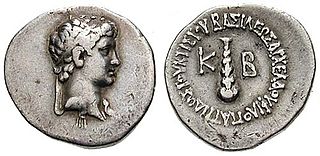
Archelaus was a Roman client prince and the last king of Cappadocia. He was also husband of Pythodorida, Queen regnant of Pontus.
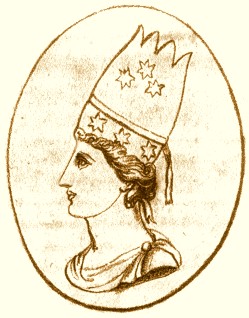
Erato was a queen of Armenia from the Artaxiad dynasty. She co-ruled as Roman client queen in 8–5 BC and 2 BC–AD 1 with Tigranes IV. Erato reigned alone in 1–2 AD. After living in political exile for a number of years, she co-ruled as Roman client queen from 6 until 12 with Tigranes V, her distant paternal relative and possible second husband. She may be viewed as one of the last hereditary rulers of her nation.

Olba or Olbe was an ancient city and bishopric in the Roman province of Isauria, in present-day southern Turkey. It is included in the Catholic Church's list of Latin titular sees.

Cleopatra VII, the last ruler of Ptolemaic Egypt, died on either 10 or 12 August, 30 BC, in Alexandria, when she was 39 years old. According to popular belief, Cleopatra killed herself by allowing an asp to bite her, but according to the Roman-era writers Strabo, Plutarch, and Cassius Dio, Cleopatra poisoned herself using either a toxic ointment or by introducing the poison with a sharp implement such as a hairpin. Modern scholars debate the validity of ancient reports involving snakebites as the cause of death and whether she was murdered. Some academics hypothesize that her Roman political rival Octavian forced her to kill herself in a manner of her choosing. The location of Cleopatra's tomb is unknown. It was recorded that Octavian allowed for her and her husband, the Roman politician and general Mark Antony, who stabbed himself with a sword, to be buried together properly.
Glaphyra was a hetaera, a form of courtesan, who lived in the 1st century BC. Glaphyra was famed and celebrated in antiquity for her beauty, charm and seductiveness. Her marriage to Archelaus the elder of Cappadocia gave her political power. Her later affair with Mark Antony occasioned a vulgar poem from Octavian Caesar.

Antirhodos was an island in the eastern harbor of Alexandria, Egypt, on which a Ptolemaic Egyptian palace was sited. The island was occupied until the reigns of Septimius Severus and Caracalla and it probably sank in the 4th century, when it succumbed to earthquakes and a tsunami following an earthquake in the eastern Mediterranean near Crete in the year 365. The site now lies underwater, near the seafront of modern Alexandria, at a depth of approximately five metres (16 ft).

The early life of Cleopatra VII of Ptolemaic Egypt covers the period from her birth in early 69 BC to her accession to the throne during or before March 51 BC. Cleopatra was the daughter of reigning pharaoh Ptolemy XII Auletes; the identity of her mother is disputed and is presumed to have been Cleopatra V or Cleopatra VI, who may have been the same person. During her early childhood, Cleopatra was brought up in the palace of Alexandria in Egypt and received a primarily Hellenistic Greek education. By adulthood she was well-versed in many languages, including Egyptian, Ethiopian, Hebrew, Arabic, Median, Parthian, Latin, and her native Koine Greek.

The reign of Cleopatra VII of the Ptolemaic Kingdom of Egypt began with the death of her father, Ptolemy XII Auletes, by March 51 BC. It ended with her suicide in August 30 BC, which also marked the conclusion of the Hellenistic period and the annexation of Egypt into a Roman province. In the style of her Greek predecessors, Cleopatra reigned over Egypt and other territories as an absolute monarch, although the Roman Republic frequently interfered in its internal affairs. Her personal rule of Egypt was characterized by a continued reliance on agriculture, extensive trade and conflict with other states, the tackling of corruption, strategic management of the bureaucracy, and ambitious building projects.

Prokles was a descendant of the exiled Spartan king Demaratus, and ruler of Pergamon in Asia Minor under the Achaemenid Empire. He was a brother of Eurysthenes, with whom he was a joint ruler.

Olba Kingdom was an ancient kingdom in south Anatolia. It was a vassal of the Seleucid and Roman Empires.